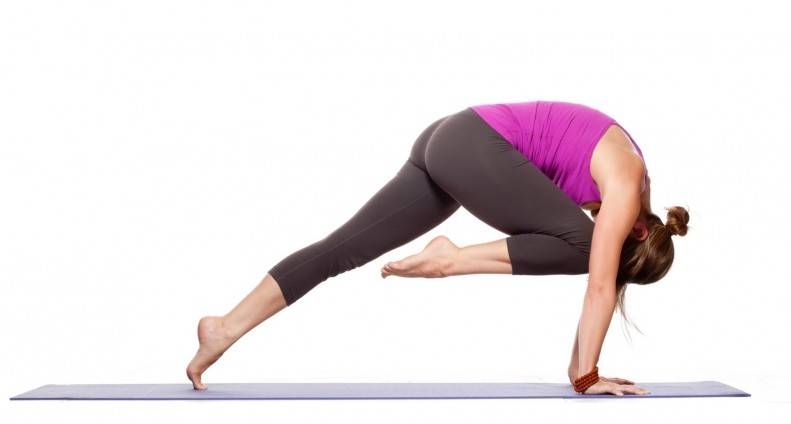Half Moon pose or Ardha Chandrasana can be very challenging for many of us. In fact it is often the peak pose in a yoga class for that very reason. Warming up and sequencing around this shape is extensive and usually involves some balancing, all the Warriors, and some core work.
Due to its difficulty, you should bring a block to your mat whenever you plan on practicing this posture as you never know how your low back and hips are going to respond once warmed up. If you have a sore low back or hips you may want to stay away from this shape until you feel stronger.
Benefits
- It strengthens the hips, ankles and inner thighs.
- It activates all the abdominal muscles, especially the obliques, and pelvic muscles significantly.
- It stretches the groin muscles.
- It’s also a tricky balancing pose, and anything that helps you practice balancing is great for growing concentration, focus and cognitive function.
Warm Up
Half Moon Pose is a shape that requires a fair amount of heat and strength in the hips, core, and low back. This means you need to spend a long time warming up.

To warm up the hips and core together you can add mountain climbers (knee to chin or elbow) to your Cat-Cows and your Surya B repetitions.
Next, hover in a yoga squat (Malasana) for 30 seconds before stepping back to Plank and stretching out in Cobra or Upward Facing Dog. Repeat these movements three or four times. Once you can easily feel some warmth in your core and hips, you might be ready to try building up to Half Moon Pose.
Peak Sequencing
There are a few ways to enter the pose, and for both, you should make sure you have a block handy at a high setting as it helps line up the spine for you. If one entrance type doesn’t work for you for any reason, try another. Beginners may even want to use a wall.

From Down Dog, lift one leg at a time to the sky and bend the knee to stack the hips. Pause for 3 breaths on each side.
Step to a High Lunge and slowly press forward into Warrior III. Hold for three breaths, practicing rooting into your standing leg and lifting your kneecap to engage your thigh muscle, while pressing into the heel of your lifted foot.
Land softly and open to Warrior II. Make sure you can see your front big toe in front of your kneecap and that your back leg is engaged, with the outer edge of the back foot pressing into the floor. Then, lean back for peaceful Warrior.
Finally open to Extended Side Angle and pause for five deep breaths, squeezing your two feet and thighs towards each other.
Entering Half Moon Pose
1. You could come up into Half Moon Pose from Side Angle
Placing your hand on a block at the top of your mat, gently lean your weight forward. Make sure to engage your core and the back leg as you lift it to help your low back. Half Moon always requires a flexed lifted foot.
2. Alternatively, go from Side Angle into a Forward Fold to Enter Half Moon
Find a halfway lift in Ardha Uttanasana (place your hands on your shin bones and extend your spine and chest forward). From there, reach your right hand down to a block directly under your shoulder. Engage your abdomen, arm and both legs to begin extending the left leg back just as you did in Warrior III.
Use the hand on your hip to turn your pelvis up towards the sky and note that your lifted toes will now point towards the wall in front of you. (If this doesn’t feel good for your hip, then choose the first option!).
To exit, come back to your Warrior II lightly and circle the hands to the ground for a vinyasa before repeating on the second side.
Cool Off
Use Pigeon pose on your belly, Forward Fold and Bridge, followed by a Reclined Twist to help unwind your Half Moon and stretch out your core, glutes, and hips.
Keeping your Half Moon pose safe requires listening acutely to your body. If our core and thigh muscles are not engaged, your back will not be safe. If your foot is not flexed, your hip will be working overtime. So go slowly into and out of this balance, and if your body says “Nope, not today” then try again a different day—and perhaps warm up a little more next time.
Image Credit: Sanaa Jaman







